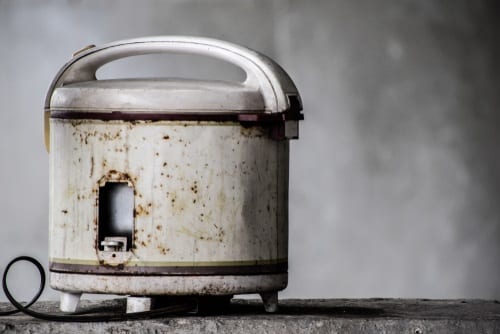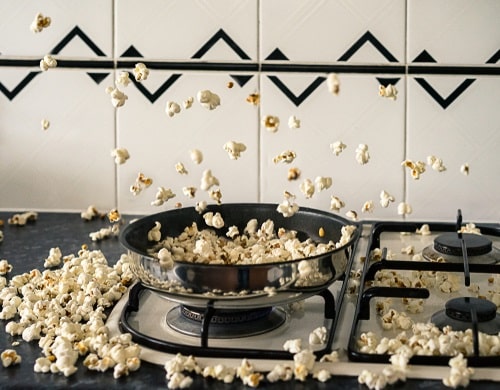
DISCLOSURE: This post may contain affiliate links, meaning when you click the links and make a purchase, I receive a commission. As an Amazon Associate I earn from qualifying purchases.
Popcorn making may seem like a daunting task, but it is surprisingly easy. It becomes a little trickier when making it on the stovetop because some of the kernels always seem to burn while others remain unpopped.
Microwave popcorn may seem like an option, but it isn’t healthy. It has been linked to a lung disease caused by the diacetyl used to give microwave popcorn its buttery taste and smell. Long-term exposure has even been linked to lung cancer.
All of this may lead you to ask, is it safe to make popcorn in a rice cooker?
It turns out that you can, but it’s not a good idea! Read on to find out why.

Popcorn making requires you to know about two important things – the right temperature and oil type. Popcorn kernels will only pop inside a very hot pan with a surface temperature exceeding 212 degrees Fahrenheit.
Such high temperatures cause low smoke point oils to burn, effectively charring the popcorns’ flavor. Only high smoke point oils, like canola, avocado, peanut, or olive oil, can cook popcorn properly without burning.
Making Popcorn in a Rice Cooker?

A rice cooker has to reach the boiling temperature of water (212 degrees Fahrenheit) to cook rice – a temperature all rice cookers can achieve.
Normally, though, a rice cooker cannot create surface temperatures higher than 212 degrees Fahrenheit because, as a safety mechanism, rice cookers switch the heat on and off with a thermostat to keep the rice just simmering and prevent it from burning.
Thus, we can safely conclude that a rice cooker is not designed to cook corn kernels.
However, since there is heat and we humans are adventurous, there is a way to cook corn kernels inside a rice cooker. The technique itself is fairly dangerous. Some of its dangers involve burning, rice cooker malfunction, and a fat hospital bill. However, if you’re willing to risk it, read on for the method. We, of course, accept no liability for any injuries or damages incurred!

To achieve a ripping hot bottom on your rice cooker, you will have to forcefully press the on button and hold it there. Doing so will keep the heat thermostat from turning off and effectively raise the rice cooker’s surface temperature above 212 degrees Fahrenheit. Once a high temperature has been achieved, popping your popcorn kernels becomes an easy thing.
What can go wrong when cooking popcorn inside a rice cooker?
Hot oil is dangerous and can cause severe skin burns. Although, it is fairly safe if you’re using a high-end rice cooker. However, since you’re using the appliance for something it was not manufactured for, it can lead to nasty accidents.
A thermal fuse, thermostat, and heating element – all three of them are essential for creating and maintaining stable heat. Cooking popcorn requires you to hold the heat button in.
This forceful exertion can ruin any one of the three essential components. Sometimes even all three of them can get severely damaged. Thus, instead of frying corn kernels, you will be frying your rice cooker’s inner parts.

Although some of these components are cheap, you will most certainly need a new rice cooker if all three of them got damaged. Is it really worth ruining a 50-dollar rice cooker to cook 2 dollars’ worth of popcorn?
Cooking popcorn in a rice cooker is not worth the risk. A hot pan on a cooking stove or hotplate does better cooking popcorn and is far less risky. In the end, a rice cooker is made to cook rice – it’s not a multi-cooker Instant Pot.
Even Instant Pots are less efficient than normal pots when it comes to cooking popcorn. So no matter what anyone else tells you or what you might have seen on the Internet, we advise you against using a rice cooker as a popcorn machine.
Rather follow these easy steps to cooking popcorn in a saucepan:
- Use a good quality, large, heavy-bottomed pot with a lid.
- Put the stove plate heat on medium-high…it is not necessary to turn it up too high.
- Put a little oil at the bottom of the pot. About three tablespoons are enough. We recommend coconut oil or olive oil.
- To test the temperature, put three popcorn kernels into the oil. When they pop, the oil is hot enough.
- Add about a third of a cup of popcorn kernels to the pot. They should be spread out in an even, single layer on the bottom of the pot. Do not use more than this for each batch because if you try to cook too many at once, some of them won’t pop.

- Put the lid on and remove the pot from the stove. Count to thirty seconds. This is to make sure that all the kernels get to the same temperature and pop together.
- Return the pot to the heat. The kernels should start to pop all at the same time within a few seconds. Gently shake the pan while this is happening.
- While the corn is popping, tilt the lid slightly to allow the steam to escape. Not too much, or some popcorn will escape!
[amazon box=”B01HRGJE88″]
- When the popping noises slow down, take the pot off the heat and tip all the popcorn into a wide-topped bowl to allow the steam to escape. Using this method, you should end up with very few unpopped kernels and no burnt ones.
- Use the still-hot pot to melt the butter if you are going to use any. Then, dribble it over the popcorn and toss it around to cover each piece evenly.
- Add any spices you fancy, such as paprika, chili powder, salt-and-vinegar spice, or grated Parmesan.
We hope you use this safer method of making popcorn rather than attempting to do it in your rice cooker! Do let us know how it goes.